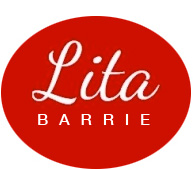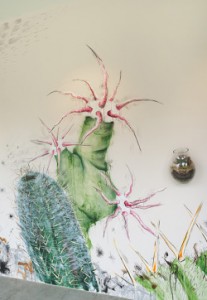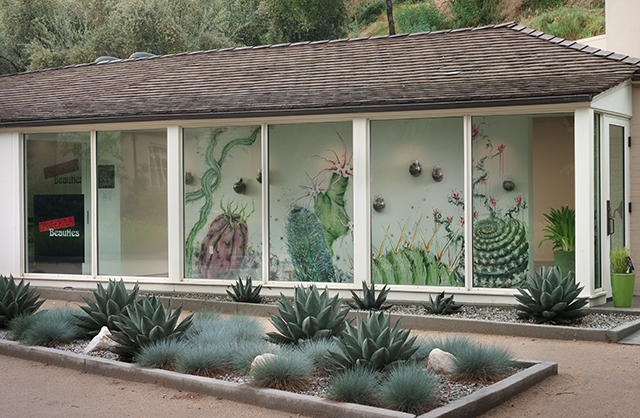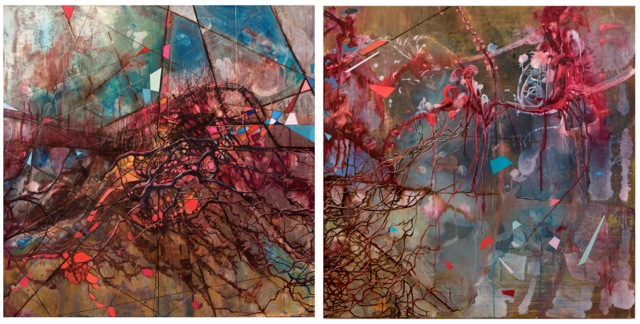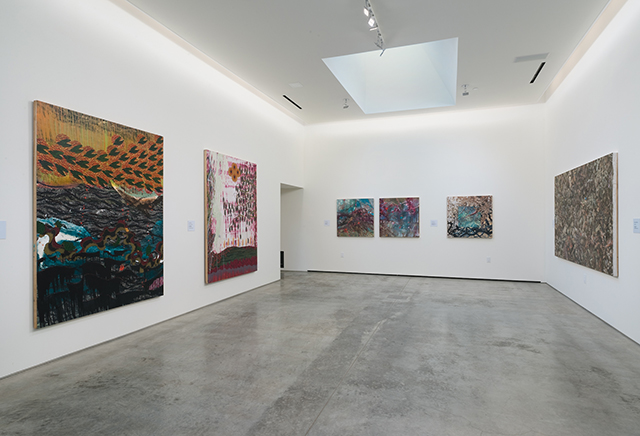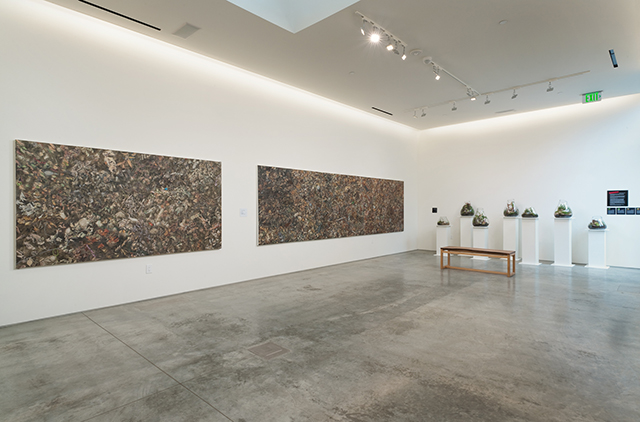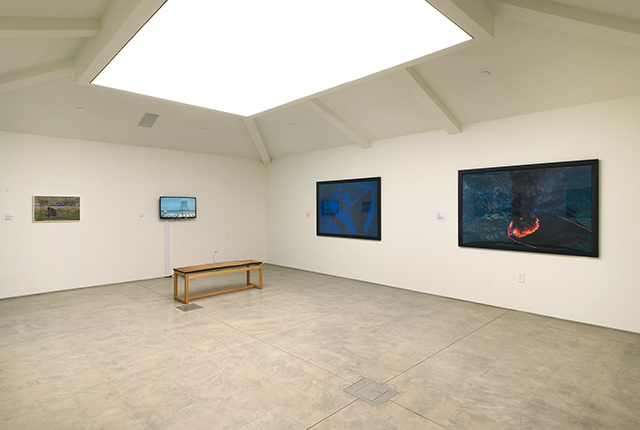Dangerous Beauties: A Double Take on Art and Nature
Front cover story ARTWEEK.LA, Vol
131, July 22, 2013
http://artweek.la/blogs/art-muse http://artweek.la/authors/lita-barrie
Dangerous Beauties, an exhibition curated by John O’Brien for Sturt Haaga Gallery at Descanso Gardens (May 7 through July 31, 2013) pairs art works with botanical plants – which are not what they appear to be, on the surface. This exhibition is a double take on the disparity between the apparently beautiful surfaces of art and nature – and the dangers which can lie beneath.
Appearances can be deceiving – and in this exhibition, the beautiful plants are actually dangerous carnivorous, toxic, nettlesome, prickly and invasive plants. The living terrariums are custom-made by horticulturalists for this exhibition. They showcase : Austrocylindropuntia (Eve’s needle), Euphorbia (Crown of Thorns), Sansevieria (African Spear), Kalanchoe (Pencil milk bush), Ilex (Holly), Zamia, Floridana, Dracaena, Codieaum (Croton) and Pachypodium. These terrariums are paired alongside paintings, photographs and video works by Southern Californian artists: Daniel Beltra, Fatemeh Burnes, Merion Estes, Samantha Fields, Mark Licari, Michael Light, Eve Luckring and Constance Mallinson.
Beauty, is not an objective quality of things – but a subjective experience which, it is often said, “lies in the eyes of the beholder”. Nature has no judgements about what is or is not considered beautiful – because nature evolves as a survival adaptation. The beauty of plants can be a lure to attract insects as food to eat. Nettles, spikes and poison can be a nasty defense against predators.
Since this art
gallery is a recent feature within the gardens (founded in 1953) its mission is to support the gardens. O’Brien (a multi-talented artist, art critic and freelance curator best known for his Brewery Projects in downtown L.A ) manages to find a balance between the gallery’s educational aspect – to support stewardship of nature – and its public aspect – to introduce visitors who are not art aficionados to local artists. Stewardship and art appreciation both require close attention to visual detail and an ability to read beneath a formal surface – in the case http://billhobbs.com/ of this exhibition, to recognize underlying paradoxes, sometimes unpleasant or even disturbing.
The artworks in this exhibition explore the natural world from distant and close perspectives – viewed from afar and above. An arresting pattern might, on closer inspection, reveal a more perilous reality (sometimes indicated by the title or caption). In Mark Licari’s mural – which is part surrealist, part comic-book illustration – monstrous plants grow like science fiction creations, juxtaposed with living terrariums.
Fatemeh Burne’s beautiful abstractions of limbs of trees and strange mutations, explore time – etched through the landscape. The title of her diptych, Hiroshima, suggests the force unleashed by violent human actions and raises ethical questions about the strange mutations caused by such invasive human technologies. In Camouflage, Burne’s carves the outer edges of a square canvas – to raise questions about the deforestation caused by artists.
Merion Estes’ Storm watch, suggests a strange migration of birds flying through an orange sky, over an inky black ocean – an anticipation of danger. In Strange Fruit, acid rain caused by pollution, wrecks havoc on plant life which falls into a primal ooze.
Constance Mallinson’s metaphoric paintings of an underbrush filled with bits of flotsam and jetsam, party remnants and even skeletal body remnants, raise questions about the carelessness of human inhabitation of nature. In Ruin, Mallinson’s intricate underbrush landscape filled with human garbage, is an admonition to be aware of the cumulative effects of human inhabitation which abuses nature as a garbage pile.
Samantha Fields’ fire paintings allude to natural fire disasters which are nature’s way of clearing brush in Southern California. But the double take in her work, is that it is unclear whether these fires are the human-made result of vandalism – or, nature’s way of finding balance by clearing brush.
Eve Luckring’s video is a portrait of her hometown, Dover, which unexpectedly houses a navy military-industrial complex with warships, helicopters and nuclear reactors – in simple Americana. Luckring is known for her Haiku poetry, which underlies her economical approach to this double take – on the face of small town America, which hides a military-industrial complex.
Daniel Beltra’s aerial photographs, Lost Horizon Oil Spill, show the after-fact of the oil spill in the gulf, on boats and rigs. Michael Light’s, aerial photographs of mountain ranges taken from a plane flying over 10,000 feet, provide an over-head view of a disturbing site in Idaho, filled with nuclear technology.
It is refreshing to view an exhibition geared to public art education (rather than to art insiders). This exhibition problematizes perceptions of beauty, in an accessible framework, by accentuating the idea of a double take – directing the viewer’s attention to a reality beneath a beautiful surface, which is anything but nice. When the German philosopher, Immanuel Kant, defined beauty as a subjective experience – the consciousness of pleasure from the “free play” of imagination and understanding – he made it clear that beauty is not objective. Kant’s philosophy marked a viagra online generic paradigm shift called the “Copernican Revolution”, which opened the way for Einstein’s ideas on relativity. Kant was responding to David Hume’s skepticism (about the existence of objects). He was the first philosopher to argue that in order to have the experience of phenomenal objects we must first impose space and time, which are SUBJECTIVE structures.
Clement Greenberg mis-used Kant’s aesthetics to support his views on reductive modernism by removing Kant’s aesthetic philosophy from its metaphysical framework and ignoring the central position of the subjectivity of aesthetic taste. As Joachim Pissaro writes “ One of the biggest differences between Kant and Greenberg is that for Kant the aesthetic judgement happens within our subjectivity. Greenberg confuses aesthetic judgements and the history of taste always
seeking objective criteria to validate the historic importance of masterpieces.” (1)
Today, the ugly and abject are often preferred to the beautiful, because they are considered more serious by pseudo-intellectuals. But this disembodied thinking which denies the senses is a patriarchal position. The Greek word aesthesis means “knowledge of the senses” and philosophical aesthetics, since Kant, is based on theorizing subjective experiences of the sensual world – which engage human imagination and understanding. The resurgence of interest in contemporary philosophical writing on beauty and the postmodern sublime, I suggest, embraces a more feminine embodied intellectual response – an antidote to patriarchal disembodied thought (which also underlies global corporate greed which disregards the environment).
O’Brien’s curatorial approach to this exhibition, does not intimidate the general public with overly obtuse philosophical concepts, or art work that would be too complex for some to comprehend. He strikes the right balance by raising curiosity about reading beneath surface beauty – which, hopefully, will introduce Southern Californian art, to the general public drawn to exploring Descanso gardens.
References
1 Pissaro, Joachim. “Greenberg, Kant and Modernism?” Source, Notes in History of Art. Vol. XX1X. Fall 2009
Note
Special thanks to John O’Brien for an insightful discussion on the curatorial mission of this exhibition which helped inform this art review.
Note
Published as the cover story in Artweek.la, July 22, 2013 Vol 131
http://artweek.la/authors/lita-barrie
htt://artweek.la/blogs/art-muse
